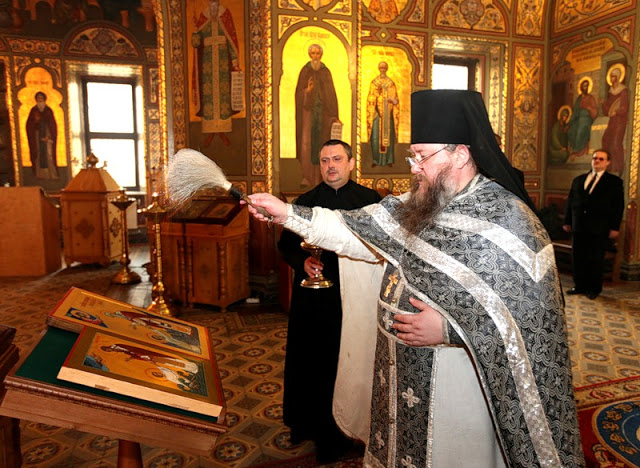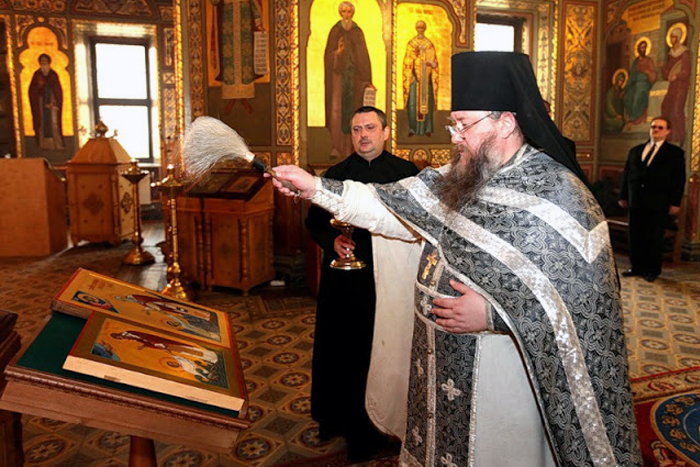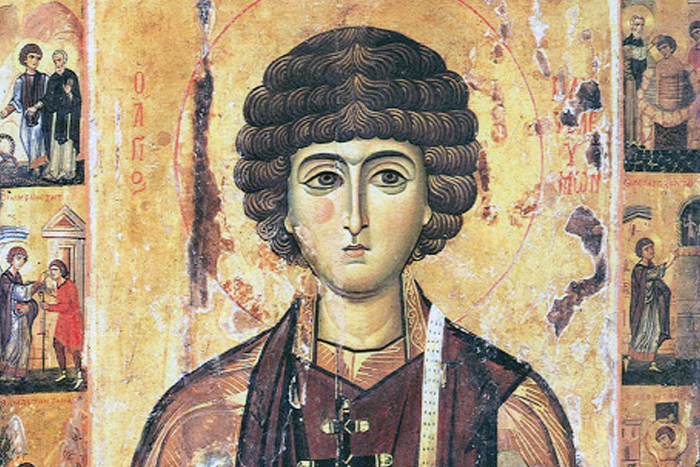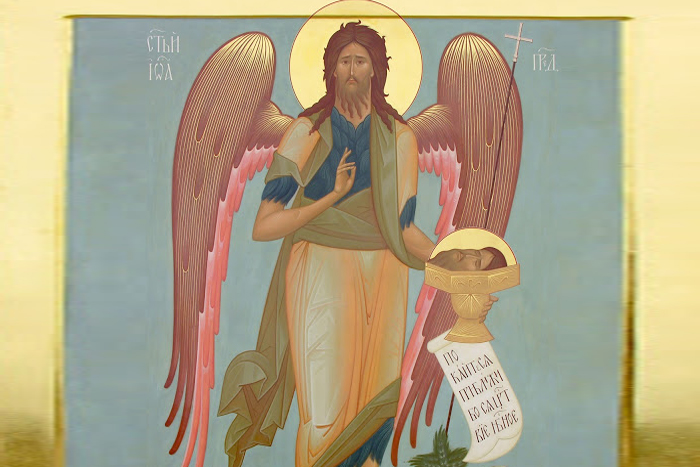One of the great difficulties that I believe the Orthodox Church has always had is control over her iconographers. More than ever, especially today, icons are being painted without understanding, and people who are not steeped in the Orthodox iconographic tradition are taking over our sacred art, teaching and painting, and their icons are ending up on our altars to be blessed, or worse, in our churches to be venerated and prayed before. The Church has attempted to deal with this situation. For example, the Hundred Chapters Council suggested that bishops and metropolitans appoint someone to be an overseer of icon studios and iconographers, to make sure that the images being produced adhered to the iconographic tradition. Yet in the 21st Century, the situation is worse than ever.
Almost anyone can become an iconographer now— regardless of talent, religious affiliation, or belief : all one really needs now is an internet connection and access to the Technique of Icon Painting or A Brush with God, and suddenly, one is an iconographer. Or take a course: a one or two-week course in iconography is offered in many places in North America, or in many of the lay academies and iconography clubs in Finland, not to mention the New Valamo Lay Academy. Granted, these courses do a great service, but one course does not an iconographer make, and we do a great disservice to the church and her tradition by not being more concerned with what is being produced.
While I was recently staying in New Valamo Monastery in Finland, a woman from the city of Tampere brought a suitcase-load of icons to the monastery to be blessed. I am not sure if all the icons were painted by her, or if she was bringing them on behalf of her iconography club, but she brought twelve icons with her. Somehow, in Finland, it has come about that having the New Valamo Monastery stamp, saying that the icon was blessed on the altar of New Valamo Monastery, is the sign that you have arrived as an iconographer, that you have become an iconographer. It is the “seal of approval.”

Unfortunately, when all of these icons were laid out on the proskemedia table and scruitinized, with much discussion between Igumen Sergei and myself, only four of the twelve were deemed blessable. The remaining icons were not blessed, for various reasons: some because of incorrect inscriptions, some because of composition, some because they were icons of saints not recognized by the Orthodox Chuch, some because of misspellings. It was truly sad to see, as the iconographer had a budding talent, but to bless these works and confer upon them the seal of blessing would be wrong, would have not done the Church or the iconographer any service. For each icon that was rejected, we sent back a note with an explanation of why the work could not be blessed, not wanting to quench the spirit, but to encourage.
Where we run into a problem today is that there is not the mechanism in our Church to judge what is being produced and reproduced. The priest in the church today has the final say as to what is blessable and what is not, and this leads to problems as well. By and large, our priests are not educated in iconology. When many of us were in seminary (I am speaking specifically about my time in St Vladimir’s Seminary in Crestwood NY), there were no classes offered on iconology. The basic instructions on what an icon is and what constitutes an icon are not taught to our seminarians, and these graduates are being priested and in turn are left to instruct and to judge what is blessable and what is not. No matter how hard they try, metropolitans, archbishops, and bishops cannot be “everywhere present and filling all things” and, unfortunately, are not all aware of what makes an icon. How can we change the situation?
First and foremost, our priests must be educated in iconology. There is no excuse for this not being a mandatory course in our seminaries. Seminarians need to be educated by an iconologist who is also an iconographer knowledgable in the tradition, who is more concerned about being an iconographer than being an artist.
Second, courses on iconology need to be given in our parishes. I make the distinction between iconography and iconology: it is not necessary that the technique of icon painting be taught, but it is necessary that the meaning of icons be taught to everyone. Too often our parishioners, cradle-born Orthodox and converts alike, are in the dark, left to their own devices as to understanding our sacred art. Too many times have I heard spurious explanations for the most simple elements that are in icons. And unfortunately in the Church, we have a tendency to over-mystify our sacred art as opposed to explaining what it truly is.
Third, besides the overall education of clergy and laity, it is also important to use the following checklist. It was developed while I was in New Valamo Monastery with the help of one of the best-known iconographers in Finland, Bishop Arseni of Joensuu. This checklist has all of the reasons why an icon would be considered unblessable by the Church. This checklist is meant to be photocopied or typed up, and brought to our altars for the priest to use, and it is also meant to be used by all iconographers to make sure that their icons meet the standards of the Orthodox Church. When an icon that causes pause is brought to the altar, the priest can go through the checklist and check off which boxes are appropriate, and return the unblessed icon to the iconographer. I was asked once how many of the boxes would need to be checked off for an icon to not be blessed, and the answer is “only one.”
This work cannot be blessed and is not considered an icon because:
1. It is a fragment of an icon, not a whole icon.
2. It is a fragment of a wall painting.
3. It does not have a feast day particular to it.
4. It does not have a name or the symbols of the name on it.
5. This is a sketch for an icon and not an actual icon.
6. There is a misspelling in the text.
7. The saint in the icon is not an Orthodox saint.
8. The inscription on this icon is incorrect.
9. This is not a canonical icon.
These points need some explanation. It is marvelous that we live in a society and a culture where we have so much print media available to us. I have many, many books on icons, from many different places in the world. I can take a book down and look at all the photographs and details of photographs of icons, and if I am not careful, I can mistake a detail for an appropriate model to paint. Unfortunately, this sometimes happens: either iconographers paint, or those who make print icons print, only details of icons and not the whole thing. A detail cannot be considered an icon, just as a photograph of a left eye cannot be considered a portrait of a person. The same is true for life icons: when we have reproductions of the life of a saint, say, for example, the familiar icon of St Herman of Alaska and the details of his life, if we take one part of that life icon, for example, St Herman’s stopping the tidal wave, or his body’s being taken from Spruce Island on a helicopter, those details cannot stand by themselves as icons. In the context of the life icon, they are perfectly acceptable, but taken out of context, they cannot be considered icons.
Similarly, fragments of wall paintings do not make panel icons. There are things that are represented on the walls of churches that—in the context of the church decoration and in the context of the church’s iconographic programme—are correct, as the decoration of the church proclaims the whole history of our salvation. Taking a detail from the walls out of context, however, causes that image to cease being an icon.
One simple definition of an icon is that it is a religious painting, in a variety of media, that has a feast day particular to it. There are events that are represented in wall paintings, for example, the miraculous draft of fish, that does not have a feast day. Or again, citing life icons, there is no feast day of St Herman’s stopping the tidal wave, just as there is no feast day of St George’s being tortured. Again, taking these elements out of context causes them to cease to be icons. The one exception to this point are icons of Christ. There is only one feast day that I know of on our calendar that is dedicated to an icon of Christ, and that is for the icon of the Face Made without Hands, on August 16. All other icons of Christ are without feast days.
To further clarify my definition of an icon, I usually add that the figures, or the main figures, have haloes, and that there are their names, or symbols of the names on the icon. If an icon of Christ or the Theotokos comes to the altar without their names, or Christ without a cross in his halo ; or if a feast is represented without the name of the feast, and the main characters without haloes or their names, the icon is unblessable. Some exceptions occur : most event icons that contain all twelve apostles do not give them all haloes and names, only the “stars” of the icon have them, to borrow from dramatic terminology. Those in supporting roles are typically represented without haloes and names.
The fifth point is something that is necessary, as I have seen in my time in New Valamo Monastery. Sometimes framed drawings for icons came across the altar to be blessed. Even though they have the potential to inspire an icon, they are not icons themselves. Many times simple line drawings are inscribed on wood using a laser : does the fact that the drawing is now on wood make it an icon? Pardon the pun, but we have to draw the line somewhere.
The sixth point is one that I experienced many times in my vocation as an iconographer. I have painted icons for people whose language of prayer was not English. I have painted icons with inscriptions in Finnish, Swedish, German, Slavonic, English, Danish, and so on. And several icons I have had sent back from the altar to have the inscriptions corrected. If an icon is a proclamation of the truth of our faith, then is it not too much to expect that the spelling be correct?
The seventh point is a contentious one. So many people today, of different faiths, paint icons. And many people bring them to Orthodox churches to have them blessed. Unfortunately, not all of the saints represented are Orthodox Saints. There is also a great danger in using the internet if you are looking for proper models, because some who call themselves iconographers have painted, in iconographic styles, saints of all different faiths, and even people that no church has recognised as saints. Even if an image is done in a Byzantine iconographic style, this does not mean that it is an icon that is blessable on an Orthodox altar. The date 1054 AD is our cut off mark for sharing saints with the Roman Catholic Church, or among some historians, 1204 AD (the Fourth Crusade), or even 1453 AD (the fall of Constantinople) Whatever the date cited as the official one for the schism between East and West, those dates need to be respected, no matter how fond we are of various holy people of other traditions. This is not to say that we cannot have devotion to these saints, or even sacred images of them, but what it does say is that these icons should not be blessed on our altars.
Point eight is a very interesting one. One of the icons that was brought to the
New Valamo Monastery altar was an icon of the Nativity. What the iconographer had written as the inscription for the icon was not “The Nativity of Christ” but “ Christ is Born, Glorify.” Also, what the iconographer had used as the model for the icon was a Christmas card. This point is clear : iconographers must use the traditional inscriptions for their icons, be they event icons or the epithets used for saints. The amount of research that one sometimes must do in order to make sure that the epithet is correct can be enormous, but just as making sure your model is within the iconographic tradition, this is also something each iconographer must do.
The last point is one that is hard to explain. As was pointed out to me by Bishop Arseni of Joensuu, checklist points one to eight are tangible: one can usually show on the panel itself what it is that prevents the icon from being blessed. The last point, however, is intangible. Again, I will blame print media (just because it is printed in a book of icons does not mean it is a canonical icon), and those iconographers who have gone before us who may have been more concerned with being artists than iconographers. Over time, icons have been produced that do not conform to the canon of iconography. For example, there is an icon of Christ the Blessed Silence. It is an image of Christ shown as an angel. It fits into the realm of the dogmatic icon, and yet it is not canonically an icon. Another type of icon that fits into this category is icons of God the Father. Even though the Hundred Chapters Council condemned the image, one can find an icon of God the Father over the royal doors in New Valamo Monastery. There is also an image of the Paternity inside the main gates of the Sergeiev-Trinity Lavra in Sergeiev Posad, home of the Moscow Spiritual Academy and its School of Iconography. These are just two examples of hundreds of non-canonicl icons out there: we must be discerning in how best to judge what is canonical.
At the same time we also must be very careful about all these listed points, because iconography is a living tradition. The Orthodox Church is not a museum of all that is ancient, but a living, vibrant Church. So too is our iconography : new saints are being canonized all the time, and new iconography is being created all the time to express the truth of the faith. One rallying cry for iconographers is that we are to imitate, not innovate, and for the most part, this is something I agree with wholeheartedly. But that does not mean there is no creativity in the bounds of the iconographic tradition. The Church does recognise new iconography: it just takes time. What is not canonical or accepted by the Church eventually disappears—or so it did once, before the advent of the internet and mass media publications.
This list does not say anything about style. It is difficult as a teacher of iconography, especially in this present age, to criticize anyone’s work. Perhaps that is why I no longer teach iconography classes. However, one must be willing to say what is good and what is not. Otherwise, the iconographer will not learn and grow. Unfortunately, when it comes down to matters of taste, if all the positive elements of this checklist are present, it needs to be up to the priest to say something. From my own experience, I am thankful for my parish priest’s admonishments, no matter how hard it was to hear at the time, that I should stop painting icons and get some proper instruction, as he could see that my work was going down the wrong path, and not being done for the glory of God.
I hope that this article is a help to iconographers, clergy, and laity alike. For the sake of the Church and her sacred art, we must educate ourselves and be diligent in the preservation of her Traditions. This is simply a beginning: as I study and paint, I realise how little I truly know and how much more there is to know about iconography. Just as being a Christian is a life-long journey, so too is the proper understanding of our Church’s sacred art.


 Unfortunately, when all of these icons were laid out on the proskemedia table and scruitinized, with much discussion between Igumen Sergei and myself, only four of the twelve were deemed blessable. The remaining icons were not blessed, for various reasons: some because of incorrect inscriptions, some because of composition, some because they were icons of saints not recognized by the Orthodox Chuch, some because of misspellings. It was truly sad to see, as the iconographer had a budding talent, but to bless these works and confer upon them the seal of blessing would be wrong, would have not done the Church or the iconographer any service. For each icon that was rejected, we sent back a note with an explanation of why the work could not be blessed, not wanting to quench the spirit, but to encourage.
Unfortunately, when all of these icons were laid out on the proskemedia table and scruitinized, with much discussion between Igumen Sergei and myself, only four of the twelve were deemed blessable. The remaining icons were not blessed, for various reasons: some because of incorrect inscriptions, some because of composition, some because they were icons of saints not recognized by the Orthodox Chuch, some because of misspellings. It was truly sad to see, as the iconographer had a budding talent, but to bless these works and confer upon them the seal of blessing would be wrong, would have not done the Church or the iconographer any service. For each icon that was rejected, we sent back a note with an explanation of why the work could not be blessed, not wanting to quench the spirit, but to encourage.







